Catholic statues and figurines | Spanish statuary
____________________________________________________________________________________________________________________________________________________

Ref: 2FA61N2-130
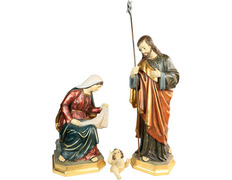
Ref: 2F207N4-80
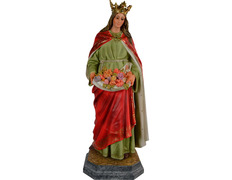
Ref: 2FA184N2-80
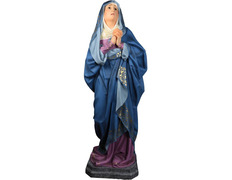
Ref: 2FA19N2-150
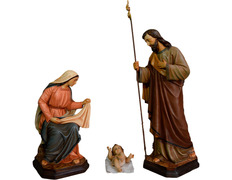
Ref: 2FA207A12-100
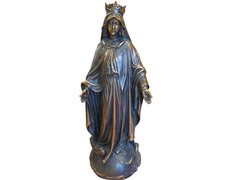
Ref: 2FR60BR
Brabander catholic figures and figurines is an online store for catholic articles selling confraternity products since 2008, with home delivery in Seville and nearby towns. Online sales with home deliveries within 24/72 hours at very affordable prices.
Visit Brabander catholic figurines if you want to learn more about our organization.
Shopping in our online store is very easy. All you need to do is:
For more information about the sales process, visit the how to buy section of our confraternity store.
Customers who shop in our online store can set the delivery address that best suits them. Our sales can be delivered to private homes, social headquarters of Confraternities and Brotherhoods, parishes, etc.
Handcrafted figures and figurines are meticulous, delicate, and require extended manufacturing times. The complete delivery process can take between 1 and 2 months.
Once we receive an order, we contact our customers to inform them of the delivery times. All orders are shipped via an urgent transport agency, with individual online tracking. The system notifies the buyer of the order's progress and allows the delivery date to be coordinated with the transport agency.
Each of the Easter processions figures, Saints figures, and monumental nativity scenes is packaged under optimal conditions:
Outer packaging: The packages are prepared with special high-strength boxes.
Inner packaging: The figures have very varied poses. The arms are often positioned away from the trunk. For this reason, filling the box inside is especially important. Catholic and confraternity figurines pieces are shipped with personalized fillings that adapt to the special characteristics of each figure.
____________________________________________________________________________________________________________________________________________________
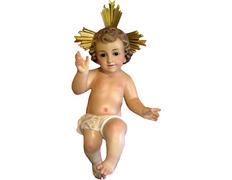
Ref: 2FA289
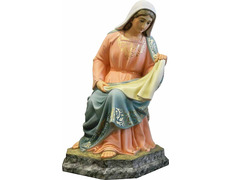
Ref: 2BA207VM

Ref: 2FA297

Ref: 2FA43

Ref: 2FA361

Ref: 2FA424

Ref: 2FA312

Ref: 2FA18

Ref: 2FA511

Ref: 2FA223
The History of Catholic Statuery in Olot
The city of Olot, located in the Garrotxa region in the province of Girona, Spain, is renowned for its rich tradition in creating Christian art from Olot. This tradition has its roots in the 18th century when Christian statues began to be produced in local workshops, mainly using wood and plaster.
The handcrafted figures, nativity scenes, and Easter procession figures made in the workshops of Olot have gained worldwide fame. The beauty of the figures' faces, the delicate finishing of each piece, the color, and the gold leaf details have captivated buyers worldwide. The catholic figurines of Olot are among the most valued pieces in parishes and confraternities in any country.
In the 19th century, catholic figurinery from Olot experienced significant growth. Many workshops in Olot emerged, excelling in creating realistic Christian figures.
These workshops, mostly family-run, specialized in the artisanal production of figures of:
Saint Margaret, Saint Anne, Saint Cecilia, Saint Gemma, Saint Caroline, Sister Angela of the Cross, etc.
Saint Joachim, Saint Jude Thaddeus, Saint Pancras, Saint Blaise, Saint Raphael, Saint Francis of Assisi, Brother Leopold, Saint Louis, Saint Anthony of Padua, Saint Ignatius of Loyola, Saint George, Saint Francis Xavier, Saint Paul, etc.
The Entry into Jerusalem, the Risen Christ, Calvary, the Pieta, the Last Supper, etc.
Marian devotions such as Our Lady of Mount Carmel, Our Lady of Fatima, Immaculate Heart of Mary, Our Lady of the Rosary, Our Lady of Guadalupe, Our Lady of Mercy, etc.
Representations and figures of the Nativity of all kinds, from the Holy Family to angels, shepherds, etc.
The term Spanish Handmade Nativity is used to identify nearly life-sized cribs with excellent finishes.
The workshops and factories that originally began as a way to create all kinds of figures and reliefs gradually specialized in the Christian world. The number of figures and representations of the Catholic Saints gradually increased as orders came in. The reputation of these pieces began to spread in religious circles.
A growing number of priests and faithful became aware of this small region of Olot, where artisans created sacred art pieces of unparalleled beauty.
The increased demand for this figure led to the growth of workshops and factories dedicated to sales. Workers from workshops and factories would typically decide to start new business ventures. Thus, new workshops emerged, such as El Sagrado Corazón, Las Artes Religiosas, El Arte Olotense, La Sagrada Familia, El Renacimiento, El Inmaculado Corazón de María, El Buen Pastor, etc.
The history of catholic figurines from Olot reached a turning point with the foundation of a Christian art workshop at the end of the 19th century. One of the first factories of its kind in Spain.
Joaquín Vayreda Vila and his brother Marià, influenced by the Parisian artistic environment and with the collaboration of the painter José Berga Boix, promoted the creation of the company Vayreda, Berga y Cía, which later led to the founding of the company El Arte Cristiano in 1880.
This pioneering workshop encouraged the creation of catholic figurines in series, using materials like wood pulp, allowing for more efficient and high-quality production. The figurines made using this technique were highly valued for their affordability while preserving traditional iconography. Despite being mass-produced, each figure was based on a unique design and modeling following the guidelines of a master sculptor.
Besides the manufacturing method, this company's major innovation to the catholic and confraternity figurines sector was using new materials. El Arte Cristiano introduced wood paste cardboard, a revolutionary material at the time. Wood or cardboard paste significantly improved production by reducing molding time and increasing the pieces' lightness and durability. It also facilitated the incorporation of elements such as glass eyes, which gave the figures great realism.
During the first half of the 20th century, the industry of religious statue factories in Spain, centered in Olot, reached its peak. The figures from Olot were exported to various countries, both in Europe and Latin America. Olot's reputation as a center for producing high-quality sacred art was solidified, with pieces that remain part of the cultural heritage of many catholic communities today, from large cathedrals to humble chapels, confraternities, and brotherhoods, etc.
The artisans of Olot have managed to adapt to the times, combining tradition with innovation. The classic techniques of wood carving and wood paste modeling remain fundamental, while new, more weather-resistant materials have been incorporated.
The production of catholic figures in Olot follows an artisanal process that ensures the quality and authenticity of each piece. Below are the key stages in creating these works:
The first step is to create an original statue that will serve as a model for the molds. This original figure is sculpted with great detail, as it will determine the quality of the subsequent reproductions.
Renowned sculptors made original sculptures for El Arte Cristiano over the years. Notable figures include Miquel Blay, Josep Clarà, Joaquim Claret, Arseni Bertrán, etc.
Original models were made with clay, a material easy to manipulate and suitable for creating highly detailed sculptures. Before working with the clay and modeling, the sculptor thoroughly studied the saints' iconography.
Each Saint, each Marian devotion, has attributes that make them recognizable to the faithful.
nce the original figure is complete, a negative silicone mold is created. This mold allows for an exact reproduction of the model, including details such as skin texture and clothing folds.
The silicone is applied carefully to capture every detail. Originally, the molds were made of natural gelatin. Generally, silicone molds consist of two parts: the figure's front and back. Joining these two parts creates the complete figure.
For more specific elements like hands, feet, angel wings, and attributes of Saints, additional molds are created. These are used to reproduce the prominent details of the figure precisely. These parts are known as "fragments" in Catalan, fragments in Spanish.
ith the silicone mold ready, it is filled with wood paste to create the main structure of the figure (head, torso, arms, and legs).
This part of the process is crucial because any filling error could ruin all the work. Ensuring the paste reaches every mold corner is essential to avoid gaps or imperfections.
Depending on the figurines, the filling process can be done in stages to incorporate reinforcement elements, such as wooden dowels. This technique is especially used for larger pieces.
Once both parts of the mold are perfectly filled, they are joined and closed with the help of the external rigid structure. Afterward, it is necessary to wait for the wood paste to harden enough for the artisans to work on it.
hen the wood paste has dried, the figure is demolded. At this point, the figure appears rough, so careful polishing is done to remove imperfections. All elements generated in the union of the two mold parts are removed, and the surface of the sculptural piece is sanded and polished to facilitate painting.
Additionally, detailed and prominent parts, such as hands, wooden paste crowns, feet, attributes, etc., are assembled. Special adhesives ensure that these parts are securely fixed to the main structure.
lass eyes are one of the distinctive features of figures crafted by Olot artisans. Glass eyes are ornamental pieces that give the figures a high degree of realism.
Placing the eyes is a delicate task that requires experienced hands. The first step is to remove the wood paste from the eye area. It is important to remove just the right amount of wood paste. Making a hole too large or too small could cause the glass eyes to not fit the religious statue's face properly.
Once the wood paste is removed from the eye area, glass eyes are inserted.
he figure is transferred to the painting room, where each artisan applies color with precision to highlight the details. The painters use historical catalogs to ensure the fidelity of the colors of each piece.
Oil paint is used for most of the figurines.
The painting process can take several hours, depending on the size, complexity of the figure, and type of finish.
El Arte Cristiano offers a series of finishes that significantly influence the purchase price of the figures. Each of these finishes has its characteristics:
The 3N finish, also known as the economical finish, is the cheapest option among the painting possibilities for El Arte Cristiano figures from Olot. It is the simplest and most minimalist option.
The garments of the Christian figurines with this particular finish are hand-painted in plain, uniform tones, giving them a classic appearance.
The edges of the mantle and tunic of the figure are delicately adorned with a line of glitter that subtly highlights the contours and adds a touch of shine.
The bases on which the catholic figurines from Olot are mounted are finished in a single color.
Metallic accessories, such as crowns or halos, are simple in design and are in harmony with the aesthetic that characterizes this type of finish.
The second decoration option for purchasing Christian figures from Olot is known as the fine finish or 2N finish.
The Christian figurines that belong to this style are the best-selling in our store due to their excellent quality/price ratio.
The clothing of each of the catholic figurines from Olot is painted with a careful combination of light and dark tones, enhancing each figure's beauty.
The borders of the mantle and tunic of the figurines are adorned with glitter, adding a touch of shine and elegance.
The bases on which these catholic statues are mounted are finished with a marble-like appearance.
The metal crowns or halos are more elaborate and showier than those of the statues with a 3N finish.
The third option for purchasing catholic statues from Olot is the superior or 1N finish.
The clothing of the catholic statues with this finish is carefully painted in a variety of light and dark tones, similar to the 2N finish, but with a greater amount of meticulous detail and more refined skin tones through a detailed and labor-intensive touch-up.
The borders of the mantle and tunic of the statue are crafted in exquisite burnished and chiseled gold leaf, giving them a much more pronounced and dazzling shine than the common glitter used in cheaper finishes.
The bases on which the catholic statues from Olot are mounted are finished in golden tones, which adds greater splendor and majesty to the complete work.
The crowns or halos that adorn these figurines are considerably more complex and elaborate than those that usually accompany the figurines with a 2N finish.
The figures with the Extra (4N) finish are specially designed for those clients seeking to acquire catholic figurines with a high level of detail and aesthetic quality.
The garments, borders of the mantle, tunic, and the bases of the catholic figurines are made through a complex and meticulous process, ensuring exceptional results.
First, a base with gold leaf is applied to the figurine, which gives the figure the shiny base that characterizes this exquisite decoration. This initial step gives the figure the final shiny finish that characterizes the catholic figurines with this decoration.
Once the gold leaf is applied, the figurine undergoes a process of polychromy, which gives the figure the necessary color nuances to highlight the details and bring life to each element of the work.
After the figurine has been polychromed, a delicate process begins through which the gold leaf sheets are polished, adding an extra shine and further refining the finish.
This action perfectly balances the shine provided by the gold leaf and the previously applied polychrome, resulting in an impressive and visually striking figurine.
The crowns or halos of these catholic figurines from Olot are of the highest quality.